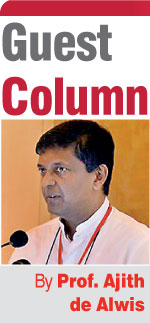Saturday Apr 19, 2025
Saturday Apr 19, 2025
Thursday, 27 June 2024 00:00 - - {{hitsCtrl.values.hits}}

Sadly, we have to manage our mess and be creative and innovative in ensuring that we come out of the woods once and for all with a message to the whole world that Sri Lanka indeed can
|
 Sri Lanka declared bankruptcy on 12 April 2022 (the local new year perhaps is better than any day to declare bad news and wonder how many astrologers indicated this to happen a regional first). It has been indicated to us that we had only $ 20 million in our national account and it was apparently a declare or die situation. Today two years later we have announced early that we are about to declare that we are not bankrupt any more. Apparently multiple tranches and additional loans plus of course some favourable remittances and trade activities have strengthened the forex balance.
Sri Lanka declared bankruptcy on 12 April 2022 (the local new year perhaps is better than any day to declare bad news and wonder how many astrologers indicated this to happen a regional first). It has been indicated to us that we had only $ 20 million in our national account and it was apparently a declare or die situation. Today two years later we have announced early that we are about to declare that we are not bankrupt any more. Apparently multiple tranches and additional loans plus of course some favourable remittances and trade activities have strengthened the forex balance.
At a personal level we all have experienced the effect of inflation and taxes and the latter is continually getting redefined on what we have to pay more. It is no secret that the tax burden has been responsible for many migrations of workers to overseas destinations (i.e., IT sector) and def broad based brain drain. Now one way of strengthening this economy is by doing things def different things that over 74 years we really avoided. Have more faith in ensuring diversity in the export basket but ensure that you are not adding more commodities but value-added products. Move into knowledge products in a meaningful way. While coming out of the bankruptcy branding is appealing what is worrying is not much action on seriously supporting the change required on the economic direction is visible. The communication from the State has also just indicated a whopping 100 billion debt value when counting both domestic and international.
We definitely did not see the type of patriotic fervour in bringing about a change like in South Korea or Thailand while enduring our crisis. The scenarios like what was observed in Japan where the managers adopted to different workwear so as to enable taking the thermostat bit higher and thus saving energy were missing. Citizenry appears desensitised to such modes of operations. The politicians only speak of doing anything when they are there and exactly what is always missing. The moment some fuel was available, running engines on cars in parking lots beating out the hot and humid conditions were back in town. May be my example is too simple and rare yet I see the poor attitude of someone who does that. Actually, contributing to two crises – economic as well as climate! Another group is keen to harvest tax rupees to boost the tax revenue by opening up the vehicle imports.
Old actions are never likely to bring new results
At each level in our organisations and institutions we must turn and request managers to think and act differently. Def to align the belief that old actions are never likely to bring new results. It is sad that we continue to see the same slow, tedious meeting after meeting to take decisions. Delegate and act for impact is missing. Managers manage or lead? The stage is for leaders at every level. Managers in search of job security push only a very weak agenda at work. When we want leaders at every level managers suddenly may find that they have to adopt a more challenging approach than one that just guarantees some continuity and stability.
This perhaps is the situational change that awaits the Sri Lankan manager. We are trying to reach the economic performance of the past – we have even indicated that we are going to give our citizenry the economy that we had in 2017 in 2029! What a far-sighted statement? What an inspirational challenge… At different levels we may gear up to bring back the past understanding the pit that we fell into due to our managers – be they be at the top, near the top or at mid-level – not exactly following aspirational goals. We spend the day negotiating for the month’s salary, beg for some relief in food and medicine and appeals to save us from internal and external conspiracies merely reciting statements verbatim which by and large has no meaning nor substance.
It is time that we realise that we are our worst enemy and the way we work we pose no threat to anybody from a competitive manner. We spend time and take due care only in image building and substance of our organisations in creating real value has long departed. Are we too late? Think not. This situation provides us with perhaps the greatest opportunity for change. The gap that we have to fill is our understanding in exactly knowing what the situation demands.
Sri Lanka is well recommended to follow a path to an innovation economy and two enablers would be technology and innovative and empowered deployment of human capital. These are two economic recommendations that have won Nobel prizes for economics. Most of the woes of Sri Lanka had come from the failure to integrate technology and that is evident when looking at agriculture to industry. Some technology integration has taken place in services but lacking transformational use had consequently failed in overall effectiveness.
An innovation economy requires a well-functioning innovation eco-system
An innovation economy requires a well-functioning innovation eco-system. The State has introduced a new national agency for innovation to the existing institutional mix – National Innovation Agency (NIA). NIA has recommended aligning all innovation actors to join in to the eco-system. There are about 83 entities in the public sector that could join in to the innovation eco-system. If we take innovation quite broadly as implemented by NIA the actors net could be flung much far and wider. The private sector assessment would enable in demonstrating what synergy could bring in with a healthy private-public sector collaboration. This aspect is a must.
We just cannot have two systems in one nation. Let’s learn from Singapore the important powerful and the significant role that its public sector plays. We at present nurture highly stereotyped notions about our public and private sectors and believe are only too happy to ensure that the differences are maintained and neither understanding that this failure to transform together is a serious stumbling block. The first step is in active engagement between management layers with a serious intent to change with common impact in mind.
There is a need to strengthen the IP system in the country to enable wealth creation for the innovation eco-system to be productive. The changes necessarily need to be understood and implemented swiftly. Sri Lankan organisations are quite poor actors on the IP stage though the British instituted mechanisms in then Ceylon, almost immediately after they did in Britain. That knowledge is central to wealth creation is a fact that our managers should realise. This definitely calls for IP literacy of the management cadre in the country.
Even the blue-chip organisations do have a poor IP portfolio. The legal system predominantly works more for the outside parties trying to ensure their rights are not violated by the malfunctioning actors of state and private sector here. Yes, most certainly management have to shift gears to ensure assets for the country from the resources – both physical and intangible – that we have here in abundance. May be the fact that we have resources in some abundance has to be understood first.
Active collaboration of research with national development goals
Research across institutions, universities should be mission oriented. The first step is in initiating active collaboration of research with national development goals. An active mechanism of evidence-based decision making, goal setting can stimulate the national research system to be more effective and impactful. Tools for understanding the dynamics would be sourced by NIA shortly.
The State should in key areas Agriculture, Energy, Environment, Industry, Transport, Education, Health and Nutrition, have specific national roadmaps with key milestones identified. As an example, two areas where there had been significant public expenditure nanotechnology and biotechnology should have defined GDP contributions from the specific technology areas. Priority should be given to remove obstacles that stand in the way of commercialisation, such as creation of special industry zones. Similarly, Hydrogen economy and Artificial Intelligence should be driven with impact-based activities. Clustering developments in high-technology export of goods and services both should be integrated to assess performance.
The proposed IoT strategies, National Industry Policy with embedded Industry 4.0 recommendation should find quick acceptance and implementation. Managers must rise up to have these as their KPIs allowing organisational transformations. Today we may be at our wits end trying to see how some assets are exchanged for some return giving one an ability to pay salaries for a few more months. Sadly, this exact scenario is present in the system and that certainly bodes badly for the nation.
National Innovation Agency has mooted that projects should be quickly scanned with an STI lens to ensure that they do have the potential to deliver value to the economy. That also means the way to run projects is not to have just pet projects which can keep systems busy but the country many not move forward. The specific science lens is promoted as then a scientific decision is made that a popular decision. Another recommendation is to start counting the intangible assets and push the value of knowledge. In creating knowledge or skilled people investments have to be made in spheres of education and research. The developed capital should be pushed back to generate rupees – the value. This latter element has failed in Sri Lanka perhaps since 1948! This value creation process has been termed Research into Rupees.
STI lens can be utilised at institutional level as well as national policy level
The STI lens and the innovation value chain management should move in research into rupees if purposefully implemented. STI lens can be utilised at an institutional level as well as at the national policy level. In order to fast-track research into impact the process of innovation vouchers is recommended to be implemented by the Treasury. Innovation vouchers would connect inventors with innovators and address the funding requirements. These are short to medium term interventions implemented to derive results and positive outcomes in turn would strengthen the process. Innovation vouchers would in some way enable overcoming the Death Valley in innovation value chain and the Darwinian sea in the same process. The financial management community must have an understanding on these necessities. The tax authorities too can have far sighted policies implemented in order to bridge these issues through taxation policies.
These steps should have a strong focused communication mechanism embedded to ensure improving S&T literacy of the nation. This communication can be developed into an action list. Sri Lanka needs some quick thinking and perhaps even quicker acting to salvage the national pride from this abyss that we have fallen into. The way most certainly is not to see the faces of incoming tourists and believing like the salvation army is coming. Sadly, we have to manage our mess and be creative and innovative in ensuring that we come out of the woods once and for all with a message to the whole world that Sri Lanka indeed can!